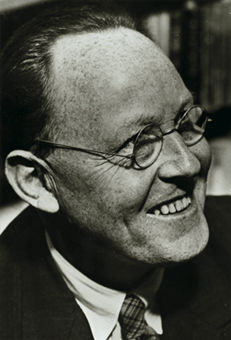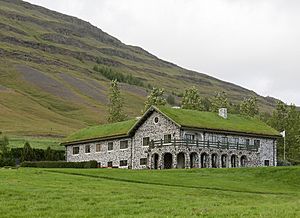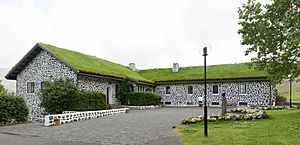Gunnar Gunnarsson facts for kids
Gunnar Gunnarsson (born May 18, 1889 – died November 21, 1975) was an author from Iceland. He mainly wrote his books in the Danish language. He grew up in a poor family in the valleys of Fljótsdalur and Vopnafjörður.
In the first half of the 1900s, Gunnar became one of the most popular writers in Denmark and Germany. He once traveled to Germany and met with Adolf Hitler. He is thought to be the only Icelander who ever met him.
Many people see Gunnar Gunnarsson as one of Iceland's most important writers. He wrote a famous novel called Af Borgslægtens Historie. It was translated into English as Guest the One-Eyed. This book was the first Icelandic story ever made into a movie. He also wrote an autobiographical novel, The Church on the Mountain, between 1923 and 1928.
Contents
Early Life and Education
Gunnar lost his mother when he was very young. He worked on his family's farm until he was 18 years old. He learned to read and write by going to small schools in the countryside.
He started writing poems and short stories early on. He published his first poetry books when he was just 17. His family did not have enough money for him to go to a regular school. But in 1907, he was able to attend the Askov Højskole in Denmark. This was a special type of school called a Folk High School. During his two years there, he decided he wanted to be a full-time writer. He also chose to write in Danish so more people could read his books.
Becoming a Famous Writer
After a few difficult years, Gunnar published his first novel in 1912. It was the first part of Af Borgslægtens Historie (Guest the One-Eyed). The next two parts came out the following year. The third part became a huge success in Denmark. This made him a well-known writer.
This long story was about three generations of Icelandic farmers. It told the tale of two brothers. One brother was a dreamer who had to choose between his creative ideas and his duties. The other brother was seen as evil at first. But in the third book, he returned as a good person. He had made up for his past mistakes by helping others.
Later Life and Works
When World War I started, Gunnar's writing became more serious. Between 1920 and 1940, he wrote many essays. These essays were about politics and social issues. He also wrote about how Nordic countries could work together. He gave many talks in the Nordic countries and in Germany.
In 1939, Gunnar moved back to Iceland. He settled at Skriðuklaustur, a farm in East Iceland. He built a house there, designed by a German architect named Fritz Höger. Later, this house was given to the Icelandic government. It was turned into a museum to remember the writer. In 1948, Gunnar moved to Reykjavík. There, he began translating his own books into Icelandic. He almost finished this work before he died in 1975.
Gunnar's books have been translated into many different languages. Besides Guest the One-Eyed, his most famous works include The Good Shepherd and The Black Cliffs. He greatly admired the old Icelandic sagas. He even translated Grettis saga into Danish.
In 1911, Gunnar published a poetry collection called Digte. He dedicated it to Franzisca Antonia Josephine Jørgensen. She was his lifelong love and partner. They got married in 1912. Franzisca Gunnarsson died one year after her husband. They were both buried on the island of Viðey, near Reykjavík. This island used to belong to a Catholic church. Gunnar was raised as a Lutheran Protestant, but his wife was Catholic.
Gunnar Gunnarsson Institute
The farm and houses at Skriðuklaustur were given to the Icelandic government by the Gunnarssons in 1948. After being fully repaired, the new Gunnarsson Institute opened in these buildings in 1997.
The institute helps people who want to write. It especially focuses on the works of Gunnar Gunnarsson. It also offers a place for artists, writers, and scholars to stay and work. The institute also helps the economy in East Iceland.
In the late Middle Ages, Skriðuklaustur was the site of a monastery. Archaeologists started digging there in 2002 to learn more about it.
Nobel Prize Nominations
Gunnar Gunnarsson was considered for the Nobel Prize in Literature several times. He was nominated in 1918, 1921, 1922, 1955, 1960, and 1961. The year 1955 was when he received the most nominations. In 1955, the Swedish Academy's Nobel committee thought about giving the prize to both Gunnarsson and the winner that year, Halldor Laxness.
See also
 In Spanish: Gunnar Gunnarsson para niños
In Spanish: Gunnar Gunnarsson para niños




